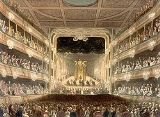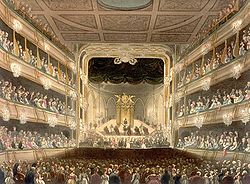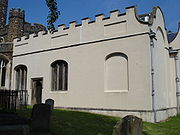
Edward Shepherd
Encyclopedia
Edward Shepherd was a prominent London
-based English architect and developer in the Georgian
period.

 Shepherd worked on the following projects, among others:
Shepherd worked on the following projects, among others:
Unfortunately, much of Shepherd's architectural work has been demolished, but perhaps his greatest legacy of the eponymous Shepherd Market, which is now a highly desirable location.
London
London is the capital city of :England and the :United Kingdom, the largest metropolitan area in the United Kingdom, and the largest urban zone in the European Union by most measures. Located on the River Thames, London has been a major settlement for two millennia, its history going back to its...
-based English architect and developer in the Georgian
Georgian architecture
Georgian architecture is the name given in most English-speaking countries to the set of architectural styles current between 1720 and 1840. It is eponymous for the first four British monarchs of the House of Hanover—George I of Great Britain, George II of Great Britain, George III of the United...
period.
Architectural work


- Cannons, a house for James Brydges, 1st Duke of ChandosJames Brydges, 1st Duke of ChandosJames Brydges, 1st Duke of Chandos, MP, PC was the first of fourteen children by Sir James Brydges, 3rd Baronet of Wilton Castle, Sheriff of Herefordshire, 8th Baron Chandos; and Elizabeth Barnard...
(1673–1744), in MiddlesexMiddlesexMiddlesex is one of the historic counties of England and the second smallest by area. The low-lying county contained the wealthy and politically independent City of London on its southern boundary and was dominated by it from a very early time...
(1723–25, now demolished). - Houses in Cavendish SquareCavendish SquareCavendish Square is a public square in the West End of London, very close to Oxford Circus, where the two main shopping thoroughfares of Oxford Street and Regent Street meet. It is located at the eastern end of Wigmore Street, which connects it to Portman Square, part of the Portman Estate, to its...
, London (1724–28). - Great Stanmore Rectory, Middlesex (1725).
- Houses in Brook StreetBrook StreetBrook Street is one of the principal streets on the Grosvenor Estate in the exclusive central London district of Mayfair. It was developed in the first half of the 18th century and runs from Hanover Square to Grosvenor Square. The continuation from Grosvenor Square to Park Lane is called Upper...
, London (1725–29). - Houses in St James's Square, London (1726–8), including No. 4, the Naval & Military ClubNaval & Military ClubThe Naval and Military Club is a gentlemen's club in London, England. It was founded in 1862 because the three then existing military clubs in London - the United Service, the Junior United Service and the Army and Navy - were all full. The membership was long restricted to military officers...
and a former home of Nancy Astor from 1912 to 1942. - Palace-fronted buildings for the 1st Duke of ChandosDuke of ChandosThe title Baron Chandos has been created twice in the Peerage of England. It was first created in 1337 when Roger de Chandos was summoned to parliament. It became extinct on his death....
in Grosvenor SquareGrosvenor SquareGrosvenor Square is a large garden square in the exclusive Mayfair district of London, England. It is the centrepiece of the Mayfair property of the Duke of Westminster, and takes its name from their surname, "Grosvenor".-History:...
, London (c1728–30, now demolished). - Goodman's Fields TheatreGoodman's Fields TheatreTwo 18th century theatres bearing the name Goodman's Fields Theatre were located on Ayliffe Street, Whitechapel, London. The first opened on 31 October 1727 in a small shop by Thomas Odell, deputy Licenser of Plays. The first play performed was George Farquhar's The Recruiting Officer. Henry...
, Ayliffe Street, WhitechapelWhitechapelWhitechapel is a built-up inner city district in the London Borough of Tower Hamlets, London, England. It is located east of Charing Cross and roughly bounded by the Bishopsgate thoroughfare on the west, Fashion Street on the north, Brady Street and Cavell Street on the east and The Highway on the...
, London (opened October 1732, demolished in 1746). - Theatre Royal, now the location of the Royal Opera HouseRoyal Opera HouseThe Royal Opera House is an opera house and major performing arts venue in Covent Garden, central London. The large building is often referred to as simply "Covent Garden", after a previous use of the site of the opera house's original construction in 1732. It is the home of The Royal Opera, The...
, Covent GardenCovent GardenCovent Garden is a district in London on the eastern fringes of the West End, between St. Martin's Lane and Drury Lane. It is associated with the former fruit and vegetable market in the central square, now a popular shopping and tourist site, and the Royal Opera House, which is also known as...
, London (opened December 1732, destroyed by fire 1808). - Development of Shepherd MarketShepherd MarketShepherd Market is a small square in the Mayfair area of central London, England. It is located between Piccadilly and Curzon Street and has a village-like atmosphere.- History :...
and adjoining streets in MayfairMayfairMayfair is an area of central London, within the City of Westminster.-History:Mayfair is named after the annual fortnight-long May Fair that took place on the site that is Shepherd Market today...
, London (1735–46). - Houses in South Audley Street, Mayfair, London (1736–37).
- Work on De Grey MausoleumDe Grey MausoleumThe de Grey Mausoleum in Flitton, Bedfordshire, England, is one of the largest sepulchral chapels in the country. It is a Grade I listed building...
, Church of St John the Baptist, Flitton, BedfordshireBedfordshireBedfordshire is a ceremonial county of historic origin in England that forms part of the East of England region.It borders Cambridgeshire to the north-east, Northamptonshire to the north, Buckinghamshire to the west and Hertfordshire to the south-east....
(1739–40).
Unfortunately, much of Shepherd's architectural work has been demolished, but perhaps his greatest legacy of the eponymous Shepherd Market, which is now a highly desirable location.
External links
- Shepherd Market, developed by Edward Shephard in 1735-46
- Edward Shepherd from Answers.comAnswers.comAnswers.com is an Internet-based knowledge exchange, which includes WikiAnswers, ReferenceAnswers, VideoAnswers, and five international language Q&A communities. The Answers.com domain name was purchased by Bill Gross and Henrik Jones at idealab in 1996. The domain name was acquired by NetShepard...
. - The Development of the Estate 1720–1785: Architects and Builders. In F. H. W. Sheppard (editor), Survey of London: volume 39: The Grosvenor Estate in Mayfair, Part 1 (General History), pages 20–24, 1977.

